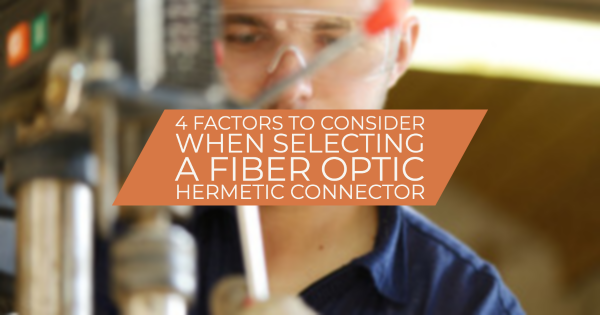When working in tough and harsh conditions, you must secure your equipment so they don’t get damaged by moisture, air, or gas. Especially if you’re an underwater engineer who relies on equipment such as underwater cameras and sonar imaging systems, you’ll need to utilize a fiber optic hermetic connector for your equipment to work efficiently. Whether the pressures are low in shallow submergence such as outboard marine motors or military antennas or deep water with pressures of 1000 bar, the hermetic seal is critical for its reliability.
Using a fiber optic hermetic connector ensures that your system functions optimally even under adverse conditions.  A fiber optic hermetic connector provides environmental protection by keeping all the connectors of your equipment sealed. That’s why it’s important to select the right fiber optic hermitic connector for your equipment. Luckily, these tips will help you select the right hermetic connectors for your application.
A fiber optic hermetic connector provides environmental protection by keeping all the connectors of your equipment sealed. That’s why it’s important to select the right fiber optic hermitic connector for your equipment. Luckily, these tips will help you select the right hermetic connectors for your application.
1. Consider the Sealing Type
Not all hermetically sealed connectors are made the same. Although sealed connectors are designed to work in pairs, there are sealing differences that you need to know. Let’s explore the different sealing types and how they compare.
Inner Sealing
This design prevents the ingress of moisture or gas between the inner and outer conductors, the insulators, and the connector body.
Panel Sealing
The panel sealing design prevents the passage of gas or moisture through a gap between the panel mounting hole and the connector body.
Mating Sealing
This design provides a waterproof function that prevents ingress of moisture or gas into the system of the two mated connectors. However, mating sealing only works when you properly mate two connectors.
Complete Sealing
This design prevents gas or moisture passage at all points of the mated connector system. A complete sealing ensures that there’s no leakage over the whole length of the connector system, which includes the jack, cable, and plug.
Knowing the different types of sealing will help you select one that’s most appropriate for your application.
2. Choose the Connector Shell
Connector shells are made from different materials and are mainly designed in two shapes: rectangular and circular. Connector shell sizes may range from 0.25 – 3.0 inches in diameter. Some of the materials used to make connectors include epoxy molded, 300 Series Stainless Steel, Kovar, Inconel, Titanium, Aluminum, and Cold Rolled Steel. The choice of material used to make connector shells depends on several factors, such as weight, availability, and durability. For instance, Epoxy, Aluminum and Titanium are lightweight and are preferable for light equipment.
3. Choose the Finishing
A fiber optic hermitic connector may be plated using different finishes, like silver plating, gold plating, copper plating, bright tin plating, and electrolytic nickel plating. Or none at all needed if epoxy molded. The primary function of a plated finish is to protect the connector against corrosion. This helps keep the high-pressure hermetic seal in optimum condition by preventing wear and tear caused by rust. Additionally, a plated finish improves the design aesthetics of your system. For instance, a gold-plated fiber optic hermetic connector will make your system look superior.
4. Consult a Connector Hermetic Seals Dealer
It may be overwhelming to choose the right fiber optic hermitic connector for your application. Besides knowing the seal types, choosing the connector shells, and the finishing of your connectors, you must also consider the correct pin configuration.
Even more, you must also consider the energy efficiency capacity of your system and select a connector that will enhance the efficiency. Good thing the modern systems are much more energy-efficient. For instance, a modern fridge uses electricity of about 1400 kWh a year compared to a fridge from the mid-80s that used approximately 350 kWh.
When you consult an expert dealer, you’ll get the fiber optic hermitic connector that’s the most appropriate for your application. Experienced dealers will help you select connectors, bulkhead electrical connectors, explosion-proof wire seals, and sealed fiber optics for your system. Choosing the right connector is important because it helps you avoid disruptions that may happen when connectors disconnect abruptly or when moisture, air, or gas leak into the connector’s interface. Contact PAVE Technology today to learn more.